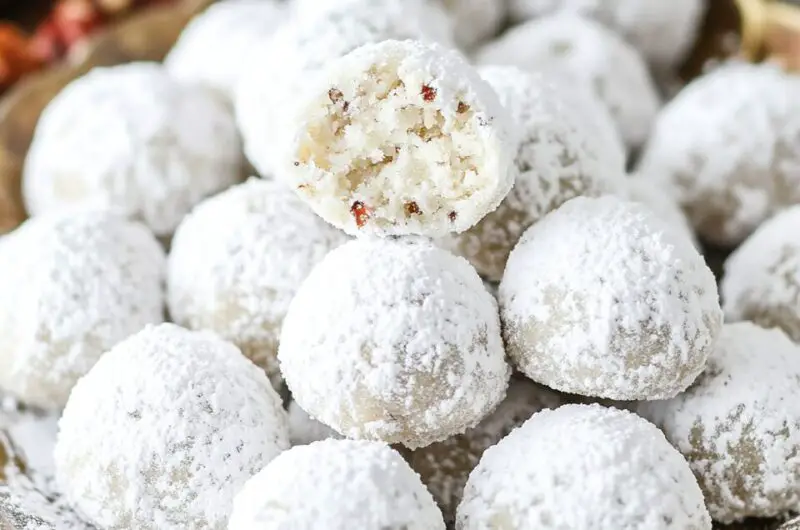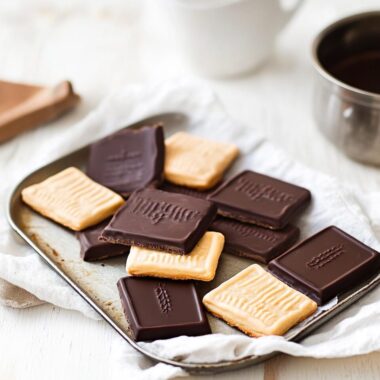The nostalgic charm of Russian Tea Cakes makes them a timeless addition to any cookie platter. With their buttery crumb, delicate nuttiness, and double layer of powdered sugar, these cookies offer a melt-in-your-mouth experience that’s perfect with a cup of tea or coffee. They’re a staple of holiday baking in many households, cherished for both their simplicity and their festive appearance. These cookies are especially popular during the winter holidays but are just as welcome any time of year. Whether you’re sharing them at a cookie swap, packaging them as a thoughtful edible gift, or baking with loved ones, Russian Tea Cakes never go out of style. Plus, they’re easy to make and require just a few pantry staples ideal for both novice bakers and seasoned pros.
Full Recipe:
Ingredients:
-
1 cup unsalted butter, softened
-
1/2 cup powdered sugar
-
1 teaspoon vanilla extract
-
2 1/4 cups all-purpose flour
-
1/4 teaspoon salt
-
3/4 cup finely chopped pecans
-
1 cup powdered sugar (for coating)
Directions:
-
Preheat oven to 350°F (175°C).
-
In a large bowl, cream together the butter and 1/2 cup powdered sugar until light and fluffy.
-
Mix in the vanilla extract.
-
Gradually add the flour and salt, mixing until just combined.
-
Fold in the chopped pecans.
-
Roll dough into 1-inch balls and place on an ungreased baking sheet.
-
Bake for 11–13 minutes, or until the bottoms are lightly golden.
-
Let the cookies cool for a few minutes, then roll them in powdered sugar while still warm.
-
Once cooled completely, roll them in powdered sugar again for a snowy finish.
Prep Time: 15 minutes | Cooking Time: 13 minutes | Total Time: 28 minutes
Kcal: 120 kcal | Servings: 24 cookies
Russian Tea Cakes: A Classic Cookie Steeped in Tradition and Sweet Simplicity
Russian Tea Cakes, also widely known as Snowball Cookies or Mexican Wedding Cookies, are among the most beloved and enduring confections found in traditional and holiday baking. These small, round, powdered sugar-coated treats have gained a reputation for being delightfully rich, nutty, and delicately sweet—an ideal accompaniment to tea, coffee, or festive gatherings. Although their name might suggest a specific Russian origin, their true history is far more global, with variations appearing in European, Middle Eastern, and Latin American cuisine.
Whether enjoyed as part of a Christmas cookie platter or served during weddings and celebrations, Russian Tea Cakes possess an old-world charm that speaks of simplicity, heritage, and warmth. In this article, we explore their origin, cultural significance, flavor profile, baking tips, and why they continue to be a favorite for bakers of all levels.
A Cookie by Many Names: The Origins and Global Variants
Despite the name “Russian Tea Cakes,” there is no definitive historical record that places their origin squarely in Russia. In fact, the name likely arose in the United States during the 20th century, where these cookies became associated with traditional Russian tea service, which often includes small pastries and confections.
Internationally, you’ll find this same cookie under a variety of names, with minor tweaks in ingredients and preparation. In Mexico and parts of Latin America, they’re known as Polvorones or Mexican Wedding Cookies. In Italy, similar treats are called Biscotti di Mandorla or almond cookies. In Greece, there is Kourabiedes, often made with almonds and sometimes flavored with ouzo or rosewater. These variations speak to a shared culinary heritage rooted in simple, high-quality ingredients flour, butter, sugar, and nuts.
The common denominator among these cookies is their crumbly, melt-in-the-mouth texture and generous coating of powdered sugar. Whether part of a wedding feast or a holiday cookie swap, their visual appeal and balanced flavor profile make them timeless.
The Signature Taste and Texture
What makes Russian Tea Cakes so distinctive is their texture and delicate flavor. The base dough is made from softened butter, flour, powdered sugar, and usually finely chopped nuts—often pecans, walnuts, or almonds. The fat from the butter creates a soft, tender crumb, while the nuts provide a subtle crunch and earthy contrast. The absence of eggs in the recipe contributes to the cookie’s dense, sandy texture, which is both rich and crumbly.
Once baked, the cookies are coated in powdered sugar first while warm, allowing some of the sugar to melt into the surface, then again after they cool for that iconic snowy finish. The result is a cookie that feels luxurious and festive, without being overly sweet or heavy. The powdered sugar melts on the tongue, giving way to a buttery interior with gentle nutty notes.
These cookies are often described as “melt-in-your-mouth,” and with good reason. Their compact size and light sweetness make it nearly impossible to eat just one. They’re also incredibly versatile: perfect for after-dinner dessert, coffee table treats, or as gifts during the holidays.
The Holiday Cookie Staple
Russian Tea Cakes are particularly popular during the Christmas season. Their snowy appearance makes them visually aligned with the wintry theme, and their rich, buttery profile complements other holiday flavors such as ginger, peppermint, and chocolate. It’s not uncommon to find them nestled among gingerbread men, shortbread, and candy canes on cookie platters across the world.
But their appeal extends beyond mere aesthetics. They hold sentimental value for many who grew up baking them with grandparents or parents during the festive season. Recipes are often passed down through generations, each family adding its own unique touch—be it a specific nut, a hint of vanilla extract, or even the inclusion of citrus zest.
Gift-worthy and transportable, these cookies also make excellent additions to cookie tins, edible holiday gifts, or winter care packages. Their sturdy structure and non-perishable ingredients make them perfect for shipping or storing for several days without sacrificing flavor or texture.
Tips for Baking the Perfect Russian Tea Cakes
While the recipe is simple, there are a few tips and tricks that can elevate your Russian Tea Cakes from good to exceptional:
1. Use Room Temperature Butter
Creaming softened butter with powdered sugar helps achieve that delicate, airy texture. Cold butter won’t mix evenly and may lead to dense cookies.
2. Finely Chop the Nuts
Finely chopped nuts ensure an even distribution throughout the dough and contribute to a smoother mouthfeel. Large chunks can disrupt the texture and cause uneven baking.
3. Double Sugar Dusting
Rolling the cookies in powdered sugar while they are warm helps it adhere and partially melt into the surface. A second coating after they cool ensures a full, even snow-dusted appearance.
4. Avoid Overbaking
These cookies don’t change color much in the oven. Look for a pale golden color on the bottoms as an indicator of doneness. Overbaking can dry them out and make them crumbly in the wrong way.
5. Cool Before Second Coating
Let the cookies cool completely before the second powdered sugar coat to maintain that iconic snowy appearance.
Variations to Try
Though the traditional recipe is hard to beat, creative bakers have experimented with various twists. Here are a few ways to change things up while keeping the heart of the cookie intact:
-
Almond Russian Tea Cakes: Use almond flour or almond extract for a nutty twist.
-
Chocolate-Dipped: Dip half of each cookie in melted dark chocolate for an elegant finish.
-
Spiced Version: Add a touch of cinnamon or cardamom to the dough for a warm, aromatic flavor.
-
Citrus Zest: Incorporate lemon or orange zest to lighten the cookie and enhance its festive notes.
-
Gluten-Free Option: Substitute a gluten-free flour blend for those with dietary restrictions.
These variations offer fresh takes while preserving the integrity of the original recipe, making them suitable for themed gatherings, seasonal experimentation, or accommodating different dietary needs.
Advertisement
Why You Should Add These Cookies to Your Baking Repertoire
Russian Tea Cakes are more than just a treat they’re an experience. Their short list of ingredients belies a deep and satisfying flavor that taps into both nostalgia and comfort. The cookies are easy to make, require no fancy equipment, and can be prepared in under an hour. Their visual appeal adds a festive touch to any dessert spread, while their flavor keeps people coming back for more.
They are also a wonderful recipe to introduce to children or novice bakers. The rolling, shaping, and sugar-coating process makes them fun and interactive, offering a chance to create memories in the kitchen. And for seasoned bakers, these cookies provide a canvas for personalization and culinary creativity.
Conclusion:
Russian Tea Cakes represent everything that’s beautiful about home baking: tradition, simplicity, and comfort. They remind us that great flavor doesn’t require complexity, and that sometimes the best recipes are those that have stood the test of time.
Whether you’re baking them for the holidays, sharing them with loved ones, or enjoying them alongside your favorite cup of tea, these cookies deliver a bite-sized celebration of flavor and nostalgia. Add them to your collection not just as a recipe, but as a tradition waiting to be made, shared, and savored year after year.








